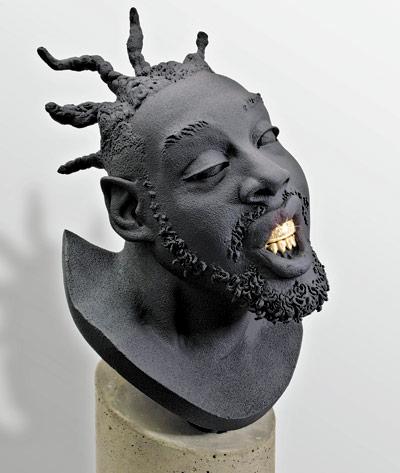‘Seeking Engagement’ Finds What It’s After

After several years writing about art critically, it is often surprising what ends up being surprising. Is it just the setting that makes a group show of East End artists so striking in a Chelsea gallery or is it the art itself?
Many, if not all, of the artists chosen by Beth McNeill for “Seeking Engagement, No Strings Attached” have shown in New York City before, but seeing them together in Lyons Wier’s cramped storefront gallery setting during a hectic opening night in the neighborhood gave the show a certain charge that may not have caught fire in the same way at a venue like Ashawagh Hall.
In any event, the animated crowd and the colorful and, indeed, engaging art did issue sparks and made for an energetic presentation that has caught notice and attention on social media, including a picture of a Jeff Muhs portrait bust of Ol’ Dirty Bastard posted on Instagram by Swizz Beatz that has received 18,800 plus likes. The bust captures the half-smile, half-glower of his grillz and is a convincing enough evocation to seem more spiritually charged than a simple death mask.
The theme of the show was initially hard to grasp from the press release, but in the setting itself, it made sense. The artists chosen, including Jack Ceglic, Tom Dash, Tapp Francke, Julia Greffenius, Nika Nesgoda, Darius Yektai, and Gavin Zeigler, have a way of drawing viewers into their work either overtly or with deliberate obfuscation.
Mr. Zeigler’s mixed-media works play with this idea in his “Peep Show” series. The works are layered with Op Art-like designs in such a way to obscure the nude models underneath, but revealing enough so that viewers are quite aware of what they are looking at. The hint of arm or other body parts is just as mysterious as the glimpse of breast here and there. Once you recognize you are not supposed to be looking at something, it charges everything not just with a hint of voyeuristic naughtiness, but also a need to overcome bewilderment. The eyes come back for more to be sure the brain can make sense of what it is seeing, putting all the parts together to make a whole.
Mr. Dash’s “Pin Ups” are more obvious in their straightforward depiction, but also share in a distancing device, this time repetition. It’s hard to engage when the images repeat like a wrapping paper design. Add language such as “Bright Like Neon Love” and suddenly the former assistant to Richard Prince seems to be taking on the mantle of that artist, putting some of his themes into his own black box to reshuffle and make them his own.
Ms. Nesgoda reimagines classical Christian imagery as photography featuring modern models, using porn stars as the leads. The show has a selection of her work, including a nursing Madonna, a couple of Annunciation scenes, and the Visitation of Mary and Elizabeth. As radical as it may sound, it is hardly new to cast the outliers of society as some as the most revered Christian icons. But the same gambit that created scandal around Caravaggio in the 16th and 17th centuries seems tamer today given the prevalence of nudity and pornography on the Internet. Still, the long and lacquered nails, the barely sheathing sheaths the models wear, the topless presentations, and lascivious glances do give the searingly bright C-prints an erotic charge that succeeds in attracting rather than turning off audiences.
The “Three Graces” of Mr. Yektai’s imagination marry many of the classical ideals of the subject to his own interpretation, abstract and surreal. Removed from a setting and cut and pasted on canvas, they look like entwined paper dolls, too ethereal to require much definition or individual detail. The faces appear to have a certain Eastern mystery that belies the idealization of the Renaissance and other neoclassical movements.
In Julia Greffenius’s compositions, she begins with paint and ends with duct tape. It gives her work a sunny optimism that lingers past what might be a one-note expression in other hands. Mr. Ceglic’s portraits are individual meditations on appearance and personality and how one can affect the other. Ms. Francke’s neon and mirror piece, “Hello” may be the most obvious of the works, but does it engage the viewer? You bet. The work is on view through Feb. 22.
